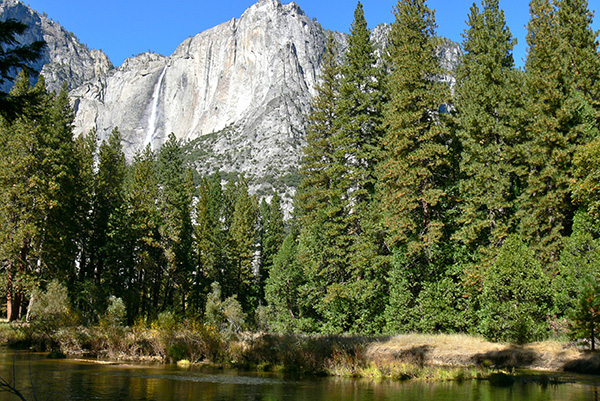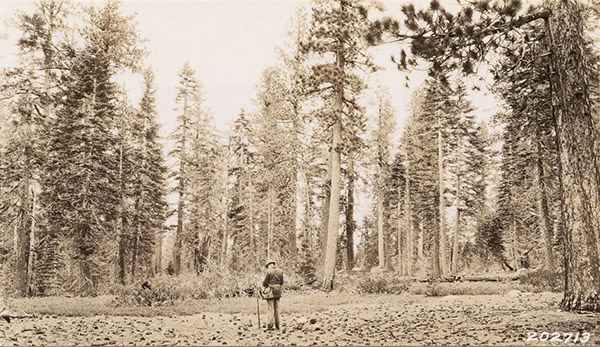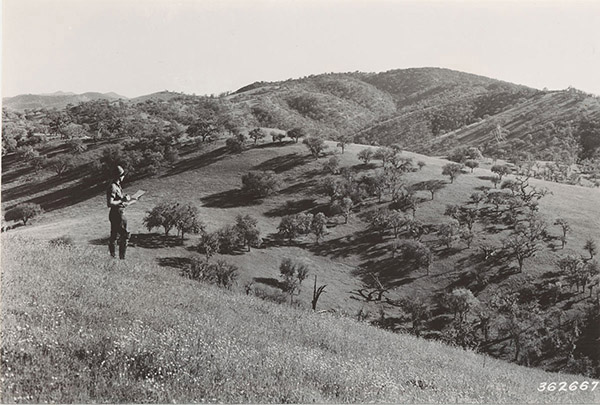
by Thea Boodhoo Thursday, May 28, 2015

Since the early 20th century, the abundance of big trees has declined in forests across California, including in the Sierra Nevada. Credit: Jodie Wilson, CC BY 2.0
From the days of John Muir’s treks through the sylvan valleys and granite peaks of the Sierra Nevada, California’s majestic forests have attracted nature lovers from around the world. Since Muir’s death in 1914, though, dramatic changes have taken hold. Across the state’s forests, small trees are more common while large trees have declined in number, and oaks seem to be taking over where pines once ruled. A new study cites drought due to warming as a major driving force behind these changes.
Previous studies attributed shifts in the makeup of California’s forests to wildfire suppression by humans, which allows for the dense growth of small trees — that is, more trees growing in a given area — and logging, which targets larger trees. However, these explanations didn’t add up for Christopher Dolanc, a biologist at Mercyhurst University in Pennsylvania who spent time in the Sierra Nevada when he was a post-doctoral researcher at the University of California at Davis.
Big trees were declining even at high elevations where logging was impractical. “Slowly but surely, we realized that this is [happening] almost everywhere in the state where there’s forest,” says Dolanc, a co-author of the new study published in Proceedings of the National Academy of Sciences. He and his colleagues began wondering if big tree mortality could be linked to the state’s long-term water issues.

A pine stand in Lassen County, Calif., Oct. 1, 1925. Credit: Wieslander Vegetation Type Mapping Collection, Marian Koshland Bioscience and Natural Resources Library, University of California, Berkeley, Calif.
To address the question, the researchers compared data on forest composition and trunk diameter from the U.S. Forest Service’s 2001-2010 Forest Inventory Analysis to data collected in the 1920s and 1930s as part of the Vegetation Type Mapping project. The comparison revealed changes in different regions of the state over a roughly 70-year period. Dolanc’s team sorted trees from both data sets into three groups based on trunk diameter: small trees (10 to 30 centimeters), medium trees (30 to 61 centimeters), and large trees (greater than 61 centimeters) about the width of an office chair or wider.
In the seven decades between the two data sets, trees in the largest group declined in number across all regions studied, which included the North Coast, Sierra foothills, Sierra highlands, South and Central Coast, and the Transverse and Peninsular ranges in the far south of the state. The Transverse and Peninsular ranges experienced the greatest loss, seeing declines from about 41 large trees per hectare in the early 20th century to roughly 11 in modern times. The foothills of the Sierra Nevada were least impacted, with big tree density dropping from about 8 to 6 trees per hectare, while the remaining regions declined by roughly half.
Over the same period, the density of small trees more than doubled in all regions studied, with the exception of the Southern and Central Coast Ranges, which did not experience a significant change. For Dolanc, the findings confirm that what he had observed in the Sierra Nevada is also happening on a statewide scale.
To determine the role of drought, the team next compared the trends in tree size through the 20th century with estimates of water stress across the state over the same time frame using an indicator known as climatic water deficit (CWD). The scientists factored in historical changes in precipitation and temperature, as well as the local topography, soil moisture and depth, evaporation and plant transpiration rates, and other hydrological factors of individual watersheds into their CWD estimates.
Including multiple variables in CWD makes it a more comprehensive indicator of water stress compared to rain and snow estimates, says Nate Stephenson, a U.S. Geological Survey research ecologist at the Sequoia and Kings Canyon Field Station in the Sierra Nevada, who was not involved in the new study. Even during times of normal precipitation, dry air makes it harder for trees to hold water due to increased evaporation. Stephenson says that CWD accurately reveals whether “plants are under greater water stress or lesser water stress.”

A blue oak woodland in Monterey County, Calif., April 1, 1938. Credit: Wieslander Vegetation Type Mapping Collection, Marian Koshland Bioscience and Natural Resources Library, University of California, Berkeley, Calif.
Dolanc’s team found, on average, that the parts of California’s forests that had seen the biggest declines in large trees through the 20th century had also accumulated the largest water deficits. The increased CWD resulted primarily from warming temperatures, the researchers suggested in their study, rather than from decreased precipitation. On the other hand, no correlation was observed between CWD and changes in the abundances of small or medium trees, suggesting “that large trees are disproportionately vulnerable to drought and water stress.” The reason for the trend isn’t yet clear, Dolanc notes.
Stephenson likens the water column in a tree to a rubber band stretched between the roots and the crown. “The taller the tree gets,” and the higher up water is stretched against the force of gravity, he says, “the more likely that rubber band is to snap.” Where that snapping point is could determine the size at which trees are dying off.
In addition to changes in tree size, Dolanc and his team also looked at two specific genera of trees — pines and oaks, which together occupy almost half of the forested areas studied — to further illuminate the link between water stress and the observed shifts in California’s forests. Pollen records dating back 150,000 years have previously shown that oaks outcompete pines during warmer, drier climates, whereas pines dominate when the climate is cooler and wetter. According to the new study, oak populations are growing in most areas — the Sierra foothills and highlands most notably — while pines numbers dropped in all areas studied. This overall shift is consistent with the warming seen in the last 70 years, the scientists reported.
Considering these changes, the forests of California’s future could look unlike anything from history. Different trees are affected by climate in different ways, Stephenson says, adding that the giant sequoias he works with are enduring so far. “Drought is one of a _bunch _of moving parts” influencing forests, he says, along with fire suppression, snow melt and plant pathogens like the one that causes sudden oak death.
It may also be possible that big tree mortality will exacerbate the current drought, due to loss of shade on the snowpack or other factors yet to be studied, Dolanc says. “That’s one of the really interesting questions for future studies.”
© 2008-2021. All rights reserved. Any copying, redistribution or retransmission of any of the contents of this service without the expressed written permission of the American Geosciences Institute is expressly prohibited. Click here for all copyright requests.